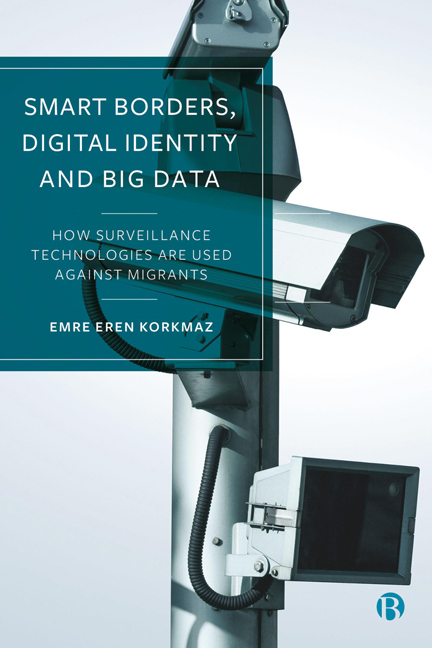 Smart Borders, Digital Identity and Big Data
Smart Borders, Digital Identity and Big Data Book contents
- Frontmatter
- Dedication
- Contents
- List of Abbreviations
- About the Author
- Acknowledgements
- Introduction: Canaries in the Coal Mine
- 1 Migration and (Surveillance) Capitalism
- 2 Migration and (Big) Data Analysis
- 3 Smart Borders
- 4 Digital Identity and Surveillance Capitalism
- Conclusion: How Can We Resist?
- Notes
- References
- Index
3 - Smart Borders
Published online by Cambridge University Press: 27 March 2024
- Frontmatter
- Dedication
- Contents
- List of Abbreviations
- About the Author
- Acknowledgements
- Introduction: Canaries in the Coal Mine
- 1 Migration and (Surveillance) Capitalism
- 2 Migration and (Big) Data Analysis
- 3 Smart Borders
- 4 Digital Identity and Surveillance Capitalism
- Conclusion: How Can We Resist?
- Notes
- References
- Index
Summary
Many of the technological solutions that stand out in the field of migration and border management fall within the scope of the tech product package known as ‘smart borders’. These ‘solutions’ make it possible to control activities beyond physical borders and to detect and prevent immigrants before they even reach borders, through such tools as AI algorithms, unmanned aerial vehicles, facial-recognition systems, biometrics, satellite images, sensors and analyses of mobile phone and social media data. For example, Elbit, an Israeli security company that established an advanced surveillance system in Arizona, can detect people approaching the border from 7.5 miles away. The laser-enhanced cameras produced by Anduril, working in the same area, are able to detect all movement within two miles and distinguish human activity from animal activity through the use of artificial intelligence (Feldstein, 2019).
Smart border applications are the most visible examples when it comes to surveillance technologies in the field of border and migration management. The reason why I have discussed big-data analysis before moving on to smart border products is that smart border applications play a prominent role in collecting real-time data on human movements, and thus contribute to the development of surveillance technologies. Flows of real-time data collected using various methods including drones, satellites and sensors, and their analysis in comparison with historical data sets, play a very important role in predicting and preventing human movements and deciding who can be permitted to cross borders.
There are two basic issues involved, which have been discussed in Chapters 1 and 2 as well. The first is the risk that, if the advanced technologies developed here are applied successfully, they might be used to monitor and steer the daily lives of entire societies. I will discuss the pilot use of lie detectors from this perspective. The second issue is that these technologies are developed by military/ arms firms, and the solutions they offer not only violate the basic rights of migrants and refugees by adopting a purely security-oriented approach, but they also militarize borders, contribute to intelligence work concerning other countries, put regional and global peace at risk and reinforce war preparations. They also provide ample opportunities for cooperation between tech companies on the one hand, and military/ arms firms and security bureaucracies, on the other.
Information
- Type
- Chapter
- Information
- Smart Borders, Digital Identity and Big DataHow Surveillance Technologies Are Used Against Migrants, pp. 68 - 86Publisher: Bristol University PressPrint publication year: 2024